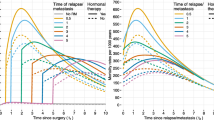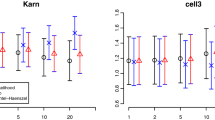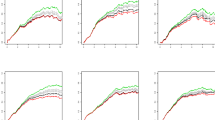Abstract
Hazard models are popular tools for the modeling of discrete time-to-event data. In particular two approaches for modeling time dependent effects are in common use. The more traditional one assumes a linear predictor with effects of explanatory variables being constant over time. The more flexible approach uses the class of semiparametric models that allow the effects of the explanatory variables to vary smoothly over time. The approach considered here is in between these modeling strategies. It assumes that the effects of the explanatory variables are piecewise constant. It allows, in particular, to evaluate at which time points the effect strength changes and is able to approximate quite complex variations of the change of effects in a simple way. A tree-based method is proposed for modeling the piecewise constant time-varying coefficients, which is embedded into the framework of varying-coefficient models. One important feature of the approach is that it automatically selects the relevant explanatory variables and no separate variable selection procedure is needed. The properties of the method are investigated in several simulation studies and its usefulness is demonstrated by considering two real-world applications.













Similar content being viewed by others
References
Adebayo SB, Fahrmeir L (2005) Analysing child mortality in Nigeria with geoadditive discrete-time survival models. Stat Med 24:709–728
Agresti A (2013) Categorical data analysis, 3rd edn. Wiley, New York
Berger M (2018) TSVC: tree-structured modelling of varying coefficients. R package version 1.2.0. https://CRAN.R-project.org/package=TSVC
Berger M, Schmid M (2018) Semiparametric regression for discrete time-to-event data. Stat Model 18:322–345
Berger M, Schmid M, Welchowski T, Schmitz-Valckenberg S, Beyersmann J (2018a) Subdistribution hazard models for competing risks in discrete time. Biostatistics. https://doi.org/10.1093/biostatistics/kxy069
Berger M, Tutz G, Schmid M (2018b) Tree-structured modelling of varying coefficients. Stat Comput. https://doi.org/10.1007/s11222-018-9804-8
Berger M, Welchowski T, Schmitz-Valckenberg S, Schmid M (2018c) A classification tree approach for the modeling of competing risks in discrete time. Adv Data Anal Classif. https://doi.org/10.1007/s11634-018-0345-y
Biasotto M, Pellis T, Cadenaro M, Bevilacqua L, Berlot G, Lenarda RD (2004) Odontogenic infections and descending necrotising mediastinitis: case report and review of the literature. Int Dental J 54:97–102
Brüderl J, Drobnic̆ S, Hank K, Huinink J, Nauck B, Neyer F, Walper S, Alt P, Borschel E, Bozoyan C, Buhr P, Finn C, Garrett M, Greischel H, Hajek K, Herzig M, Huyer-May B, Lenke R, Müller B, Peter T, Schmiedeberg C, Schütze P, Schumann N, Thönnissen C, Wetzel M, Wilhelm B (2018) The German family panel (pairfam). GESIS Data Archive, Cologne. ZA5678 Data file Version 9.1.0. https://doi.org/10.4232/pairfam.5678.9.1.0.
Burnham R, Rishi RB, Bridle C (2011) Changes in admission rates for spreading odontogenic infection resulting from changes in government policy about the dental schedule and remunerations. Br J Oral Maxillofac Surg 49:26–28
Cai Z, Sun Y (2003) Local linear estimation for time-dependent coefficients in Cox’s regression models. Scand J Stat 30:93–111
Cox DR (1972) Regression models and life-tables. J R Stat Soc, Ser B (Stat Methodol) 34:187–220 (with discussion)
De Boor C (1978) A practical guide to splines. Springer, New York
Djeundje VB, Crook J (2018) Dynamic survival models with varying coefficients for credit risks. Eur J Oper Res 275:319–333. https://doi.org/10.1016/jejor201811029
Eilers PH, Marx BD (1996) Flexible smoothing with B-splines and penalties. Stat Sci 11:89–102
Fahrmeir L, Wagenpfeil S (1996) Smoothing hazard functions and time-varying effects in discrete duration and competing risks models. J Am Stat Assoc 91:1584–1594
Groll A, Tutz G (2017) Variable selection in discrete survival models including heterogeneity. Lifetime Data Anal 23:305–338
Hastie T, Tibshirani R (1993) Varying-coefficient models. J R Stat Soc, Ser B (Stat Methodol) 55:757–796
Heim N, Berger M, Wiedemeyer V, Reich RH, Martini M (2018) A mathematical approach improves the predictability of length of hospitalization due to acute odontogenic infection. A retrospective investigation of 303 patients. J Cranio-Maxillofac Surg 47:334–340. https://doi.org/10.1016/jjcms201812002
Heyard R, Timsit JF, Essaied W, Held L (2018) Dynamic clinical prediction models for discrete time-to-event data with competing risks—a case study on the OUTCOMEREA database. Biom J. https://doi.org/10.1002/bimj201700259
Huininik J (2014) Alter der Mütter bei Geburt des ersten und der nachfolgenden Kinder - europäischer Vergleich. In: Deutsche Familienstiftung (Hrsg) Wenn Kinder - wann Kinder? Ergebnisse der ersten Welle des Beziehungs- und Familienpanels. Parzellers Buchverlag, Fulda, pp 13–26
Huinink J, Brüderl J, Nauck B, Walper S, Castiglioni L, Feldhaus M (2011) Panel analysis of intimate relationships and family dynamics (pairfam): conceptual framework and design. J Fam Res 23:77–101
Kalbfleisch JD, Prentice R (2002) The survival analysis of failure time data, 2nd edn. Hoboken, Wiley
Kandala NB, Ghilagaber G (2006) A geo-additive Bayesian discrete-time survival model and its application to spatial analysis of childhood mortality in Malawi. Qual Quant 40:935–957
Klein J, Möschberger M (2003) Survival analysis: statistical methods for censored and truncated data. Springer, New York
Klein JP, Houwelingen HCV, Ibrahim JG, Scheike TH (2016) Handbook of survival analysis. Chapman & Hall, Boca Raton
Lambert P, Eilers P (2005) Bayesian proportional hazards model with time-varying regression coefficients: a penalized Poisson regression approach. Stat Med 24:3977–3989
Möst S, Pößnecker W, Tutz G (2016) Variable selection for discrete competing risks models. Qual Quan 50:1589–1610
Rao D, Desai A, Kulkarni R, Gopalkrishnan K, Rao C (2010) Comparison of maxillofacial space infection in diabetic and nondiabetic patients. Oral Surg, Oral Med, Oral Pathol, Oral Radiol, Endod 110:e7–e12
Ruhe C (2018) Quantifying change over time: interpreting time-varying effects in duration analyses. Polit Anal 26:90–111
Sargent DJ (1997) A flexible approach to time-varying coefficients in the Cox regression setting. Lifetime Data Anal 3:13
Schmid M, Tutz G, Welchowski T (2017) Discrimination measures for discrete time-to-event predictions. Econom Stat 7:153–164
Tian L, Zucker D, Wei L (2005) On the Cox model with time-varying regression coefficients. J Am Stat Assoc 100:172–183
Tutz G, Binder H (2004) Flexible modelling of discrete failure time including time-varying smooth effects. Stat Med 23:2445–2461
Tutz G, Schmid M (2016) Modeling discrete time-to-event data. Springer, New York
Van den Berg GJ (2001) Duration models: specification, identification and multiple durations. In: Heckman JJ, Leamer E (eds) Handbook of econometrics. North Holland, Amsterdam
Welchowski T, Schmid M (2018) discSurv: discrete time survival analysis. R package version 1.3.4. http://CRAN.R-project.org/package=discSurv
Willett JB, Singer JD (1993) Investigating onset, cessation, relapse, and recovery: why you should, and how you can, use discrete-time survival analysis to examine event occurrence. J Consult Clin Psychol 61:952–965
Wood SN (2011) Fast stable restricted maximum likelihood and marginal likelihood estimation of semiparametric generalized linear models. J R Stat Soc: Ser B (Stat Methodol) 73:3–36
Wood SN (2017) Generalized additive models: an introduction with R, 2nd edn. Chapman & Hall, Boca Raton
Wood SN (2018) mgcv: mixed GAM computation vehicle with GCV/AIC/REML smoothness estimation. R package version 1.8-15. https://CRAN.R-project.org/package=mgcv
Xu R, Adak S (2002) Survival analysis with time-varying regression effects using a tree-based approach. Biometrics 58:305–315
Yee TW (2010) The VGAM package for categorical data analysis. J Stat Softw 32:1–34
Yee TW (2017) VGAM: vector generalized linear and additive models. R package version 1.0-4. https://CRAN.R-project.org/package=VGAM
Acknowledgements
This paper uses data from the German Family Panel pairfam, coordinated by Josef Brüderl, Karsten Hank, Johannes Huinink, Bernhard Nauck, Franz Neyer, and Sabine Walper. Pairfam is funded as long-term project by the German Research Foundation (DFG).
Funding
The work was supported by the German Research Foundation (DFG), Grant SCHM 2966/2-1.
Author information
Authors and Affiliations
Corresponding author
Additional information
Publisher's Note
Springer Nature remains neutral with regard to jurisdictional claims in published maps and institutional affiliations.
Appendix 1: Augmented data matrices of the TSVC model given in Eq. (14)
Appendix 1: Augmented data matrices of the TSVC model given in Eq. (14)
For an individual whose event was observed (\(\varDelta _i=1\)) at time \(\tilde{T}_i\) the augmented data matrix after a split in \(x_j\) at split point \(t^*_{j1}\) is given by

For an individual that is censored \((\varDelta _i=0)\) at time \(\tilde{T}_i\) the augmented data matrix after a split in \(x_j\) at split point \(t^*_{j1}\) is given by

The matrices (17) and (18) contain two columns associated with the jth explanatory variable including the values \(\varvec{x}_{ij}^\top \,I(t\le t^*_{j1})\) and \(\varvec{x}_{ij}^\top \,I(t>t^*_{j1})\).
Rights and permissions
About this article
Cite this article
Puth, MT., Tutz, G., Heim, N. et al. Tree-based modeling of time-varying coefficients in discrete time-to-event models. Lifetime Data Anal 26, 545–572 (2020). https://doi.org/10.1007/s10985-019-09489-7
Received:
Accepted:
Published:
Issue Date:
DOI: https://doi.org/10.1007/s10985-019-09489-7




